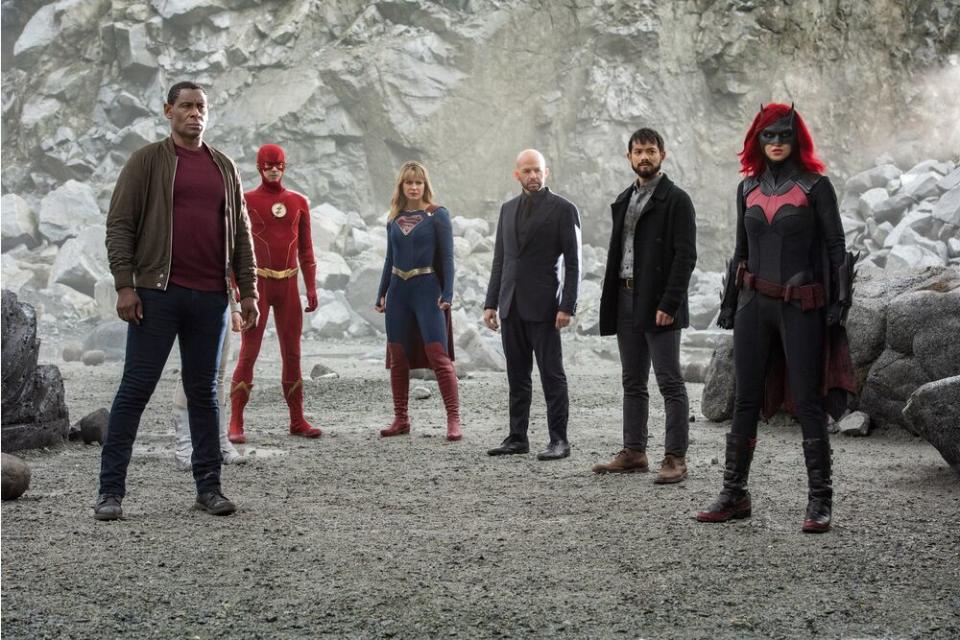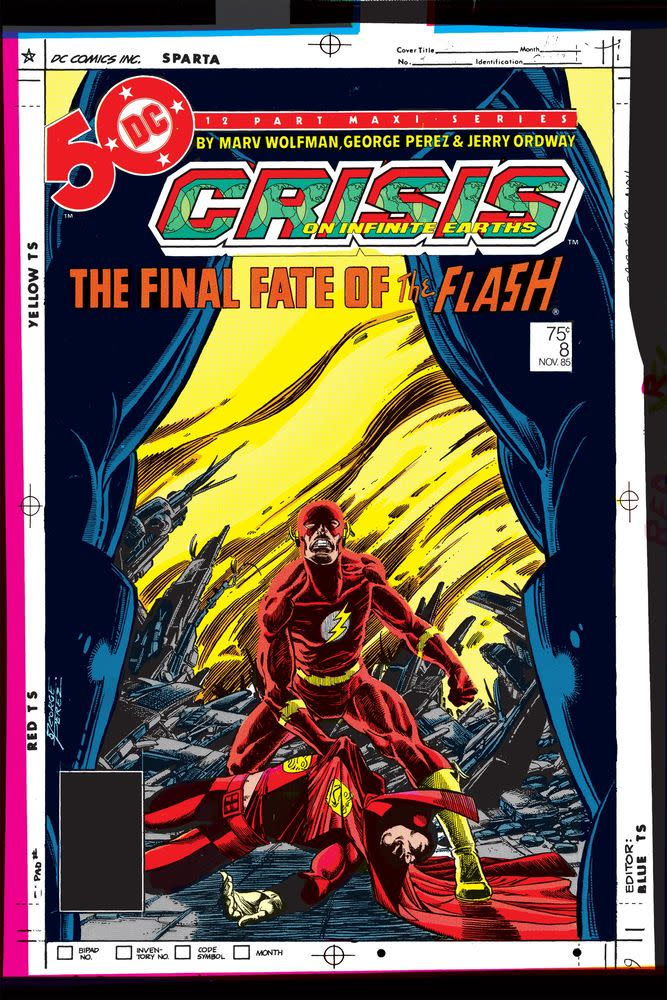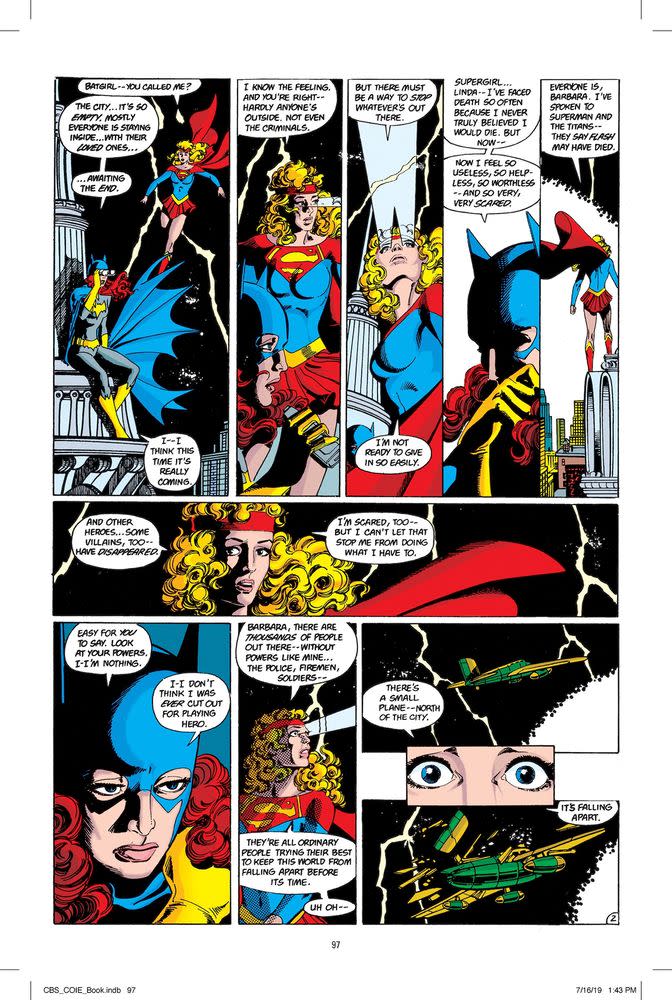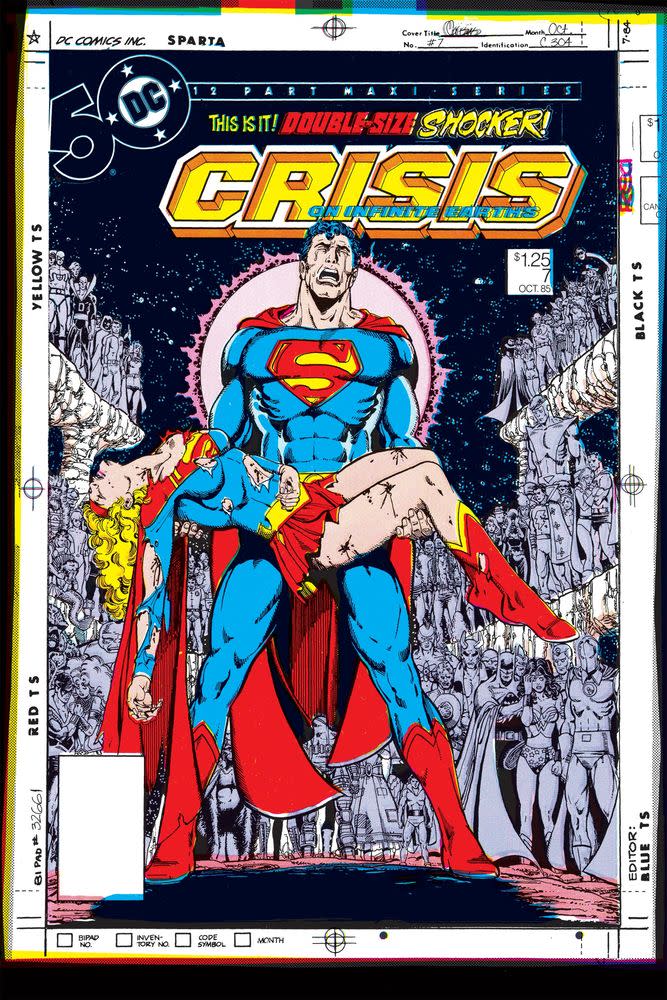Crisis on Infinite Earths creators reveal what they'd change in their iconic comic
Marv Wolfman and George Pérez, the writer and artist behind DC Comics’ groundbreaking series Crisis on Infinite Earths, are still surprised that their 12-issue saga has endured for so long, let alone become the basis of a major television crossover event.
“We never, not once, ever assumed this would be remembered 35, 40 years later, or that it would be five episodes of TV,” Wolfman tells EW. “This is far beyond anything we imagined.”
“I never could have imagined it could have been adapted,” Pérez adds. “It had over 500 characters, which also had 500 different continuities going for them.”
And yet, as unlikely as it once seemed, Crisis has finally come to the small screen.
This winter, the CW’s superhero shows — Arrow, The Flash, Supergirl, DC’s Legends of Tomorrow, and Batwoman — have been staging their own version of Crisis in a massive crossover, which concludes Tuesday with two episodes. While the Arrowverse had to modify the story to suit its needs, it’s paying homage to the many different corners of the DC universe in the same way the comic did when it was released. Not only that, but Wolfman co-wrote part 4 (the Arrow episode) with executive producer Marc Guggenheim.

“I was dealing now with a story that dealt with a different multiverse than I had done in the comic, but it was still the fun of doing that type of story line and making sure that that one worked well,” says Wolfman. “Marc was just utterly incredible to work with. I was thrilled.”
Published from 1985 to 1986, Crisis forever altered the DC Comics universe. In the story, DC’s heroes and villains band together to fight the Anti-Monitor, who is trying to destroy the multiverse. When Wolfman conceived and pitched the tale in the early ’80s, he viewed it as a way to bring more readers to DC Comics, which was trailing rival publisher Marvel. It was a daunting task, in part because DC’s continuity had too many confusing parallel Earths, which made jumping in difficult for new readers. Crisis was supposed eliminate all those alternate worlds and create a streamlined new universe. Although Wolfman and Pérez were focused on telling the best story they could, they imagined people would ultimately be more interested in what came after Crisis.
“To me and George, this was the roadmap to where you were going to the new DC universe. We didn’t think anyone would remember Crisis except as this book that took you to someplace,” Wolfman says. “What’s happened is Crisis itself has become the focal point, that people really love the book. We never assumed it would be this big fan favorite as it is now. It boggles the mind.”

The comic has remained popular for so long because of its scope (it features almost every DC character, with Pérez drawing more than 400 faces) and major twists — specifically the shocking deaths of Supergirl in issue #7 and the Barry Allen Flash one issue later. Wolfman planned on killing Supergirl from the beginning, but it was DC who asked that the Flash meet his end as well.
“We had worked up a list of characters who we thought should die,” Woflman recalls. “It sounds horrible talking about it in that fashion now. Flash was not on that list. Supergirl was number one on that list because as we were going to revive Superman and make him a stronger character for 1986 onward, we wanted Superman to be the sole survivor of Krypton. So Supergirl was definitely on the list and we were surprised that DC had no problem with that. The Flash I was asked to put in, and I really didn’t want to because I thought of him as the character who initiated the Silver Age of comics. But they wanted it.”
He continues, “We set it up by having him appear as a ghostly image, and for issues you were trying to figure out what’s going on. For the fans, they were seeing it as that. For me, it was like I was delaying the death of the Flash because I knew I had to do it but I didn’t want to.”

Pérez looks back on his work on the Flash’s death with pride. “It was a dramatic ending — obviously, he deteriorated as he ran — but the fact no one else in the story is witnessing [adds to the emotional impact],” he says. “So [it’s] like I’m chronicling an event that no one else is witnessing. It had a great ton of dramatic irony in that it is so pivotal, yet until the very end of the story no one’s going to know about this.”
While fans remember the big deaths and other dramatic moments, Wolfman’s favorite scene is Supergirl and Batgirl’s heart-to-heart at the beginning of issue #4. “It worked as a character piece really powerfully because you generally don’t see superheroes doubting each other or doubting what they’re capable of doing,” Wolfman says. It was a really strong personal moment between two of the female characters, and it was a really good way to just tying in with where we were going to go in two or three issues.”

Though Wolfman and Pérez are proud of the entire book, there are a few things they would change if they could. For Wolfman, he would have liked to keep his original ending. When he first pitched the book, none of the characters were supposed to remember the Crisis, but in the finished product several characters remember, including Psycho Pirate.
“My view was if you are trying to create a universe without any of the complications of the confusion, you should create that new universe of nobody remembered what had preceded it,” Wolfman says. “But that was overruled. We made it as strong as possible by just having a small number of characters remember.”
Wolfman also would have increased the size of each book. “George’s artwork is so incredible that I wish we were able to have twice as many pages but no more story, so that he could draw bigger pictures and we could see how much more beautiful it is,” he says. “I think it’s the best stuff of his career, and best of mine. It’s so strong. I would just love people to see it, to have seen it [on] full pages rather than 30 panels on a page, or 100 characters in a panel, just to show off his work.”
Pérez agrees with the sentiment, because he would’ve been able to fit in even more characters in. “I’m sure there are some characters out there I must have missed or would’ve liked to have given them more of a spotlight,” he says, adding that he wish he could’ve drawn faster, too. “One thing I had to sacrifice after the first couple of issues of Crisis was I was doing tight little pencils, and I had to abandon that if [I wanted] to maintain a schedule and meet my deadlines on the book.
“But the book came out fine,” he continues. “It’s obviously held up for several decades now, and it’s so fond to remember. And it created a phrase that did not exist in DC Comics up until then. There was [now] the idea of pre-Crisis and post-Crisis. The fact that, my God, I am part of a turning point in DC Comics, I’m very proud of that.”

The Arrowverse’s “Crisis on Infinite Earths” crossover concludes Tuesday, Jan. 14, with Arrow at 8 p.m. ET/PT and Legends of Tomorrow at 9 p.m. ET/PT, on the CW.
Related content:

